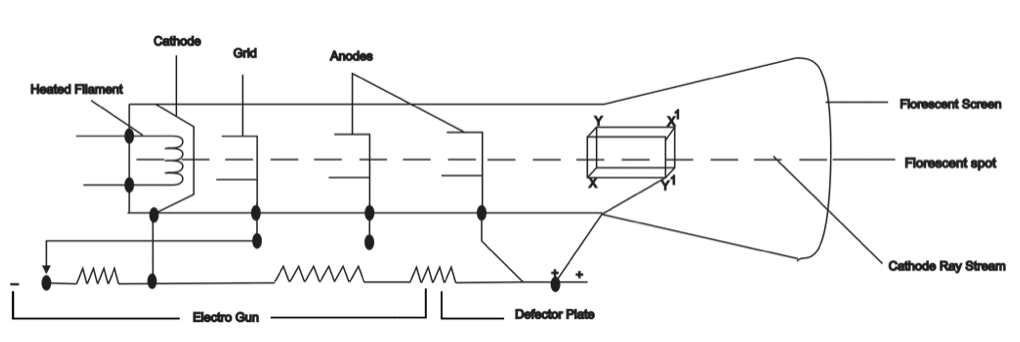A hot cathodeA cathode is the electrode from which a conventional current leaves the electrolyte. It is the negative part of the cell where reduction takes place. More is another way of producing free electrons in contrast to what happens in a discharge tube when electrons are produced from a cold cathode.
Whenever metal is heated to a sufficiently high temperature, electrons are emitted from the surface of the metal.
Thermionic Emission
Thermionic emission is the giving off or emission of electrons from the surface of a metal when they are heated to a sufficiently high temperature.

When the tungsten filament is heated to a high temperature, the extra energyEnergy is the ability to do work. Energy exists in several forms such as heat, kinetic or mechanical energy, light, potential energy, and electrical energy. Units of Energy: The SI unit... More is given to its free electron at the surface of the metal which enables it to break through the surface of the metal and exist outside it as an electric cloud. This is the process of thermionic emission and the emitting filament is the hot cathode.
When plate A is positive with respect to hot cathode it attracts the free electrons of the electron cloud and current flows as shown but when negative, it repels the electrons and no current flows.
Thermionic Devices:
Thermionic devices are devices that operate on the principle of thermionic emission. They include :
• Diode valve
• X-ray tube
• Cathode ray tube
Diode Valve
A diode is an electrical device that allows current to flow only in one direction.
It consist of anodeAn anode is an electrode of a polarized electrical device through which conventional current enters the device. It is the positive part of electrolytes where oxidation takes place. More A, usually in form of cylinder, a hot filament heater madeof tungsten wire and a cathode, hence emitted electrons flows toward the cathode.
A diode characteristic curve shows that it does not obey ohm’s law hence, a non-ohmic conductor and it can be used as a reactor to produce a d.c from an a.c supply.

Similarities between Thermionic Emission and Liquid Vaporization
- Heat is involved in both processes
- Both occur at the surface of the material
- The rate of the phenomenon increases with temperature
- Particles are released in both cases
Differences
- Thermionic emission takes place at the metal surface while vaporization takes place at liquid surface
- Electrons are released in thermionic emission while water molecules are released during vaporization
- Thermionic emission occurs at a definite temperature while vaporization occurs at all temperatures
Cathode Ray Oscilloscope (CRO)
Cathode ray oscilloscope uses the principle of thermionic emission. This is a device used for studying all types of waveforms especially the alternating current waveform. Also, it is used to measure frequencies and the amplitude of voltage of electronic devices.

The Cathode ray oscilloscope is a vacuumA vacuum is an area of space containing little or no matter (solids, liquids, and gases). It is a space with nothing in it, not even air. More tube containing electron guns at one end, and a fluorescent screen at the other end; in between these are two pairs of deflector plates near the middle of the tube
A Cathode ray oscilloscope contains
- A highly evacuated glass tube open at one end out to form a screen which is coated with a mixture of fluorescent material (zinc sulphate)
- A filament at the opposite end of the screen from which electrons are emitted after heating.
- A cylindrical anode that helps attract and focus accelerated electrons emitted on the screen
- Two pairs of plate X and Y in between the anode and the screen. The X plate provides the time base axis and the Y plate traces the ordinate axis which makes the plotting of the wave form possible



Responses